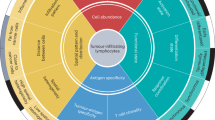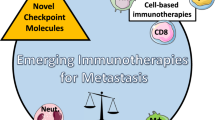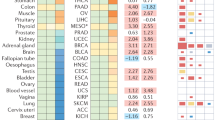Abstract
The success of cancer immunotherapies is predicated on the targeting of highly expressed neoepitopes, which preferentially favours malignancies with high mutational burden. Here we show that early responses by type-I interferons mediate the success of immune checkpoint inhibitors as well as epitope spreading in poorly immunogenic tumours and that these interferon responses can be enhanced via systemic administration of lipid particles loaded with RNA coding for tumour-unspecific antigens. In mice, the immune responses of tumours sensitive to checkpoint inhibitors were transferable to resistant tumours and resulted in heightened immunity with antigenic spreading that protected the animals from tumour rechallenge. Our findings show that the resistance of tumours to immunotherapy is dictated by the absence of a damage response, which can be restored by boosting early type-I interferon responses to enable epitope spreading and self-amplifying responses in treatment-refractory tumours.
This is a preview of subscription content, access via your institution
Access options
Access Nature and 54 other Nature Portfolio journals
Get Nature+, our best-value online-access subscription
$32.99 / 30 days
cancel any time
Subscribe to this journal
Receive 12 digital issues and online access to articles
$119.00 per year
only $9.92 per issue
Buy this article
- Purchase on SpringerLink
- Instant access to full article PDF
Prices may be subject to local taxes which are calculated during checkout








Similar content being viewed by others
Data availability
The main data supporting the results in this study are available within the paper and its Supplementary Information and provided as supplementary source data. Raw data for sequencing results can be found at https://www.ncbi.nlm.nih.gov/geo/query/acc.cgi?acc=GSE255666. Source data are provided with this paper.
References
Bagchi, S., Yuan, R. & Engleman, E. G. Immune checkpoint inhibitors for the treatment of cancer: clinical impact and mechanisms of response and resistance. Annu. Rev. Pathol. 16, 223–249 (2021).
Sharma, P. & Allison, J. P. The future of immune checkpoint therapy. Science 348, 56–61 (2015).
Granier, C. et al. Mechanisms of action and rationale for the use of checkpoint inhibitors in cancer. ESMO Open 2, e000213 (2017).
Wei, S. C., Duffy, C. R. & Allison, J. P. Fundamental mechanisms of immune checkpoint blockade therapy. Cancer Discov. 8, 1069–1086 (2018).
Verma, V. et al. A systematic review of the cost and cost-effectiveness studies of immune checkpoint inhibitors. J. Immunother. Cancer 6, 128 (2018).
Chauhan, A., Burkeen, G., Houranieh, J., Arnold, S. & Anthony, L. Immune checkpoint-associated cardiotoxicity: case report with systematic review of literature. Ann. Oncol. 28, 2034–2038 (2017).
Snyder, A. et al. Genetic basis for clinical response to CTLA-4 blockade in melanoma. N. Engl. J. Med. 371, 2189–2199 (2014).
Rizvi, N. A. et al. Mutational landscape determines sensitivity to PD-1 blockade in non-small cell lung cancer. Science https://doi.org/10.1126/science.aaa1348 (2015).
Kandoth, C. et al. Mutational landscape and significance across 12 major cancer types. Nature 502, 333–339 (2013).
Fares, C. M., Van Allen, E. M., Drake, C. G., Allison, J. P. & Hu-Lieskovan, S. Mechanisms of resistance to immune checkpoint blockade: why does checkpoint inhibitor immunotherapy not work for all patients? Am. Soc. Clin. Oncol. Educ. Book 39, 147–164 (2019).
Jenkins, R. W., Barbie, D. A. & Flaherty, K. T. Mechanisms of resistance to immune checkpoint inhibitors. Br. J. Cancer 118, 9–16 (2018).
Morad, G., Helmink, B. A., Sharma, P. & Wargo, J. A. Hallmarks of response, resistance, and toxicity to immune checkpoint blockade. Cell 184, 5309–5337 (2021).
Fuertes, M. B., Woo, S. R., Burnett, B., Fu, Y. X. & Gajewski, T. F. Type I interferon response and innate immune sensing of cancer. Trends Immunol. 34, 67–73 (2013).
Benci, J. L. et al. Tumour interferon signaling regulates a multigenic resistance program to immune checkpoint blockade. Cell 167, 1540–1554.e12 (2016).
Wang, X. et al. Suppression of type I IFN signaling in tumours mediates resistance to anti-PD-1 treatment that can be overcome by radiotherapy. Cancer Res. 77, 839–850 (2017).
Jacquelot, N. et al. Sustained type I interferon signaling as a mechanism of resistance to PD-1 blockade. Cell Res. 29, 846–861 (2019).
Zhou, L. et al. A dual role of type I interferons in antitumour immunity. Adv. Biosyst. 4, e1900237 (2020).
Diamond, M. S. et al. Type I interferon is selectively required by dendritic cells for immune rejection of tumours. J. Exp. Med. 208, 1989–2003 (2011).
Fuertes, M. B. et al. Host type I IFN signals are required for antitumour CD8+ T cell responses through CD8α+ dendritic cells. J. Exp. Med. 208, 2005–2016 (2011).
Sayour, E. J. et al. Personalized tumour RNA loaded lipid-nanoparticles prime the systemic and intratumoural milieu for response to cancer immunotherapy. Nano Lett. 18, 6195–6206 (2018).
Sayour, E. J. et al. Systemic activation of antigen-presenting cells via RNA-loaded nanoparticles. Oncoimmunology 6, e1256527 (2016).
Kariko, K., Buckstein, M., Ni, H. & Weissman, D. Suppression of RNA recognition by Toll-like receptors: the impact of nucleoside modification and the evolutionary origin of RNA. Immunity 23, 165–175 (2005).
Baklaushev, V. P. et al. Luciferase expression allows bioluminescence imaging but imposes limitations on the orthotopic mouse (4T1) model of breast cancer. Sci. Rep. 7, 7715 (2017).
Mendez-Gomez, H. R. et al. RNA aggregates harness the danger response for potent cancer immunotherapy. Cell 187, 2521–2535.e1 (2024).
Ansari, A. M. et al. Cellular GFP toxicity and immunogenicity: potential confounders in in vivo cell tracking experiments. Stem Cell Rev. Rep. 12, 553–559 (2016).
Poloni, C. et al. T-cell activation-induced marker assays in health and disease. Immunol. Cell Biol. 101, 491–503 (2023).
Reck, M. et al. Updated analysis of KEYNOTE-024: pembrolizumab versus platinum-based chemotherapy for advanced non-small-cell lung cancer with PD-L1 tumour proportion score of 50% or greater. J. Clin. Oncol. 37, 537–546 (2019).
Samstein, R. M. et al. Tumour mutational load predicts survival after immunotherapy across multiple cancer types. Nat. Genet. 51, 202–206 (2019).
Llosa, N. J. et al. The vigorous immune microenvironment of microsatellite instable colon cancer is balanced by multiple counter-inhibitory checkpoints. Cancer Discov. 5, 43–51 (2015).
Valero, C. et al. Response rates to anti-PD-1 immunotherapy in microsatellite-stable solid tumours with 10 or more mutations per megabase. JAMA Oncol. 7, 739–743 (2021).
Hildner, K. et al. Batf3 deficiency reveals a critical role for CD8α+ dendritic cells in cytotoxic T cell immunity. Science 322, 1097–1100 (2008).
Woo, S. R. et al. STING-dependent cytosolic DNA sensing mediates innate immune recognition of immunogenic tumours. Immunity 41, 830–842 (2014).
Suschak, J. J., Wang, S., Fitzgerald, K. A. & Lu, S. A cGAS-independent STING/IRF7 pathway mediates the immunogenicity of DNA vaccines. J. Immunol. 196, 310–316 (2016).
Ayers, M. et al. IFN-γ-related mRNA profile predicts clinical response to PD-1 blockade. J. Clin. Invest. 127, 2930–2940 (2017).
Karachi, A. et al. Modulation of temozolomide dose differentially affects T-cell response to immune checkpoint inhibition. Neuro Oncol. 21, 730–741 (2019).
Zhai, Y. et al. Cloning and characterization of the genes encoding the murine homologues of the human melanoma antigens MART1 and gp100. J. Immunother. 20, 15–25 (1997).
Zhang, C. et al. Identification of Claudin-6 as a molecular biomarker in pan-cancer through multiple omics integrative analysis. Front. Cell Dev. Biol. 9, 726656 (2021).
Mansour, M. et al. Therapy of established B16-F10 melanoma tumours by a single vaccination of CTL/T helper peptides in VacciMax. J. Transl. Med. 5, 20 (2007).
Rosenberg, S. A. Development of cancer immunotherapies based on identification of the genes encoding cancer regression antigens. J. Natl Cancer Inst. 88, 1635–1644 (1996).
Overwijk, W. W. & Restifo, N. P. B16 as a mouse model for human melanoma. Curr. Protoc. Immunol. https://doi.org/10.1002/0471142735.im2001s39 (2001).
Balmas, E. et al. Islet-autoreactive CD4+ T cells are linked with response to alefacept in type 1 diabetes. JCI Insight https://doi.org/10.1172/jci.insight.167881 (2023).
Acknowledgements
We thank G. Moore for assistance with veterinary animal experiments; D. Li and Biostatistics and Computational Biology Shared Resource for statistical support; L. Fagman and K. Young for help with large animals; and A. Dongtao Fu of the UF Molecular Pathology Core at the Department of Pathology, Immunology and Laboratory Medicine for assistance with genomics experiments. Cartoon images including those for mouse, canine, and schematics in figures were created with BioRender.com. This work was supported by federal awards W81XWH-17-1-0510, K08CA199224, R37CA251978, R01CA266857, R01FD007268 (FDA – OOPD, Office of Orphan Products Development), and P30CA247796; Florida Department of Health 20B11 (Bankhead Coley) and 20L07 (Live Like Bella) awards; and foundation grants from CureSearch (Catapult Award), Alex’s Lemonade Stand (R Accelerated Award), Rally Foundation, Hyundai Hope on Wheels (Hope Scholar Award), Stop Children’s Cancer and the Bonnie R. Freeman Professorship for Pediatric Oncology Research, Danny’s Dream, the Medulloblastoma Initiative (MBI) and Cure Group 4 Medulloblastoma Consortium, Ians Friends Foundation, and the National Pediatric Cancer Foundation.
Author information
Authors and Affiliations
Contributions
S.Q., B.W. and B.D.S. designed and performed the experiments, interpreted the data and co-wrote the paper. D.Z. conducted experimental studies and generated RNA vaccine reagents. J.M., F.W. and J.C.-R. conducted experiments. A.G. assisted with experiments and co-wrote the paper. A.D., C.Z., C.M., A.K., C.X., G.J., R.L., S.M., X.M., R.S.F.M., C.v.R., D.T.N., L.E., N.T., A.B., H.G., Y.C., E.O-R, C.R. and D.S. conducted/assisted with experiments. J.H. provided resources and oversight. S.C.-J. led canine studies. K.F. led H&E organ analyses. N.L.S., W.G.S., M.R., J.A.L. and C.T.F. provided critical resources and oversight. J.-H.L. oversaw statistical analyses. D.A.M. provided key resources and oversight. P.C. and H.R.M.-G. designed and performed experiments, interpreted data and co-wrote the paper. E.J.S. conceived and designed studies, performed experiments, provided resources and co-wrote the paper.
Corresponding author
Ethics declarations
Competing interests
D.A.M. and C.T.F. hold an ownership interest in iOncologi, Inc. W.G.S. holds interest in Aurita, Inc. E.J.S. is a paid consultant for Siren Biotechnology and serves on the external advisory board of Nature’s Toolbox with stock options. The paper discusses pending patent applications from S.Q., J.M., A.G., W.G.S., M.R., D.A.M., P.C., H.R.M.-G. and E.J.S, some of which are licensed to iOncologi, Inc. H.R.M.-G. and E.J.S. receive royalty payments from iOncologi, Inc.
Peer review
Peer review information
Nature Biomedical Engineering thanks Yang-Xin Fu and the other, anonymous, reviewer(s) for their contribution to the peer review of this work.
Additional information
Publisher’s note Springer Nature remains neutral with regard to jurisdictional claims in published maps and institutional affiliations.
Supplementary information
Supplementary Information
Supplementary Figs. 1–15 and Table 1.
Supplementary Data
Source data for supplementary figures.
Source data
Source Data
Source data for Figs. 1–8.
Rights and permissions
Springer Nature or its licensor (e.g. a society or other partner) holds exclusive rights to this article under a publishing agreement with the author(s) or other rightsholder(s); author self-archiving of the accepted manuscript version of this article is solely governed by the terms of such publishing agreement and applicable law.
About this article
Cite this article
Qdaisat, S., Wummer, B., Stover, B.D. et al. Sensitization of tumours to immunotherapy by boosting early type-I interferon responses enables epitope spreading. Nat. Biomed. Eng 9, 1437–1452 (2025). https://doi.org/10.1038/s41551-025-01380-1
Received:
Accepted:
Published:
Issue date:
DOI: https://doi.org/10.1038/s41551-025-01380-1



